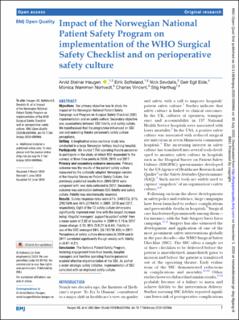| dc.contributor.author | Haugen, Arvid Steinar | |
| dc.contributor.author | Søfteland, Eirik | |
| dc.contributor.author | Sevdalis, Nick | |
| dc.contributor.author | Eide, Geir Egil | |
| dc.contributor.author | Nortvedt, Monica Wammen | |
| dc.contributor.author | Vincent, Charles | |
| dc.contributor.author | Harthug, Stig | |
| dc.coverage.spatial | Norway | en_US |
| dc.date.accessioned | 2020-12-01T14:03:31Z | |
| dc.date.available | 2020-12-01T14:03:31Z | |
| dc.date.created | 2020-10-29T10:49:37Z | |
| dc.date.issued | 2020 | |
| dc.identifier.citation | Haugen, A. S., Søfteland, E., Sevdalis, N., Eide, G. E., Nortvedt, M. W., Vincent, C., & Harthug, S. (2020). Impact of the Norwegian National Patient Safety Program on implementation of the WHO Surgical Safety Checklist and on perioperative safety culture. BMJ Open Quality, 9(3) | en_US |
| dc.identifier.issn | 2399-6641 | |
| dc.identifier.uri | https://hdl.handle.net/11250/2711246 | |
| dc.description.abstract | Objectives Our primary objective was to study the impact of the Norwegian National Patient Safety Campaign and Program on Surgical Safety Checklist (SSC) implementation and on safety culture. Secondary objective was associations between SSC fidelity and safety culture. We hypothesised that the programme influenced on SSC use and operating theatre personnel’s safety culture perceptions.
Setting A longitudinal cross-sectional study was conducted in a large Norwegian tertiary teaching hospital.
Participants We invited 1754 operating theatre personnel to participate in the study, of which 920 responded to the surveys at three time points in 2009, 2010 and 2017.
Primary and secondary outcome measures Primary outcome was the results of the patient safety culture measured by the culturally adapted Norwegian version of the Hospital Survey on Patient Safety Culture. Our previously published results from 2009/2010 were compared with new data collected in 2017. Secondary outcome was correlation between SSC fidelity and safety culture. Fidelity was electronically recorded.
Results Survey response rates were 61% (349/575), 51% (292/569) and 46% (279/610) in 2009, 2010 and 2017, respectively. Eight of the 12 safety culture dimensions significantly improved over time with the largest increase being ‘Hospital managers’ support to patient safety’ from a mean score of 2.82 at baseline in 2009 to 3.15 in 2017 (mean change: 0.33, 95% CI 0.21 to 0.44). Fidelity in use of the SSC averaged 88% (26 741/30 426) in 2017. Perceptions of safety culture dimensions in 2009 and in 2017 correlated significantly though weakly with fidelity (r=0.07–0.21).
Conclusion The National Patient Safety Program, fostering engagement from trust boards, hospital managers and frontline operating theatre personnel enabled effective implementation of the SSC. As part of a wider strategic safety initiative, implementation of SSC coincided with an improved safety culture. | en_US |
| dc.language.iso | eng | en_US |
| dc.publisher | BMJ Group | en_US |
| dc.rights | Navngivelse-Ikkekommersiell 4.0 Internasjonal | * |
| dc.rights.uri | http://creativecommons.org/licenses/by-nc/4.0/deed.no | * |
| dc.title | Impact of the Norwegian National Patient Safety Program on implementation of the WHO Surgical Safety Checklist and on perioperative safety culture | en_US |
| dc.type | Peer reviewed | en_US |
| dc.type | Journal article | en_US |
| dc.description.version | publishedVersion | en_US |
| dc.rights.holder | © Author(s) (or their employer(s)) 2020 | en_US |
| dc.subject.nsi | VDP::Medisinske Fag: 700::Helsefag: 800::Helsetjeneste- og helseadministrasjonsforskning: 806 | en_US |
| dc.subject.nsi | VDP::Medisinske Fag: 700::Klinisk medisinske fag: 750::Generell kirurgi: 780 | en_US |
| dc.source.pagenumber | 1-9 | en_US |
| dc.source.volume | 9 | en_US |
| dc.source.journal | BMJ Open Quality | en_US |
| dc.source.issue | 3 | en_US |
| dc.identifier.doi | 10.1136/bmjoq-2020-000966 | |
| dc.identifier.cristin | 1843201 | |
| dc.relation.project | Helse Vest RHF: HV1172 | en_US |
| cristin.ispublished | true | |
| cristin.fulltext | original | |
| cristin.qualitycode | 1 | |

